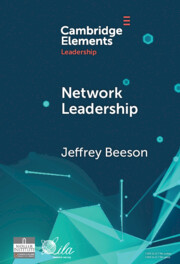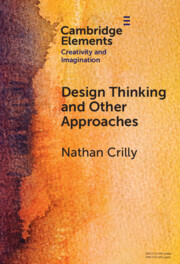Refine search
Actions for selected content:
61 results
Impact factor: Playing a number on you
-
- Journal:
- Quantitative Plant Biology / Volume 6 / 2025
- Published online by Cambridge University Press:
- 14 November 2025, e33
-
- Article
-
- You have access
- Open access
- HTML
- Export citation
7 - Systems Thinking, Process Philosophy, and Moral Imagination
-
- Book:
- Moral Imagination in the Twenty-first Century
- Published online:
- 30 October 2025
- Print publication:
- 13 November 2025, pp 140-156
-
- Chapter
- Export citation
Systems thinking and aircraft design: managing complexity
-
- Journal:
- The Aeronautical Journal , First View
- Published online by Cambridge University Press:
- 07 November 2025, pp. 1-16
-
- Article
- Export citation
The historical role of system dynamics modelling in understanding and supporting integrated natural resource management
-
- Journal:
- Cambridge Prisms: Water / Volume 3 / 2025
- Published online by Cambridge University Press:
- 21 May 2025, e6
-
- Article
-
- You have access
- Open access
- HTML
- Export citation
Polycrisis patterns: applying system archetypes to crisis interactions
- Part of
-
- Journal:
- Global Sustainability / Volume 8 / 2025
- Published online by Cambridge University Press:
- 20 May 2025, e17
-
- Article
-
- You have access
- Open access
- HTML
- Export citation
Understanding the determinants of malnutrition among adolescent girls in Pakistan: what needs to be done?
-
- Journal:
- Nutrition Research Reviews / Volume 38 / Issue 2 / December 2025
- Published online by Cambridge University Press:
- 21 April 2025, pp. 730-735
-
- Article
-
- You have access
- Open access
- HTML
- Export citation
Unraveling deep roots in drylands: a systems thinking participatory approach to SDGs
- Part of
-
- Journal:
- Global Sustainability / Volume 8 / 2025
- Published online by Cambridge University Press:
- 21 February 2025, e13
-
- Article
-
- You have access
- Open access
- HTML
- Export citation
On the scaling of digital twins by aggregation
-
- Journal:
- Data & Policy / Volume 7 / 2025
- Published online by Cambridge University Press:
- 22 January 2025, e9
-
- Article
-
- You have access
- Open access
- HTML
- Export citation

Network Leadership
- Promoting a Healthier World through the Power of Networks
-
- Published online:
- 09 January 2025
- Print publication:
- 16 January 2025
-
- Element
- Export citation
Four SINS in behavioural public policy
-
- Journal:
- Behavioural Public Policy / Volume 9 / Issue 2 / April 2025
- Published online by Cambridge University Press:
- 16 December 2024, pp. 345-353
-
- Article
-
- You have access
- Open access
- HTML
- Export citation
Review of systems thinking in rural WASH programming and research
-
- Journal:
- Cambridge Prisms: Water / Volume 2 / 2024
- Published online by Cambridge University Press:
- 09 December 2024, e12
-
- Article
-
- You have access
- Open access
- HTML
- Export citation

Supply Chain Management
-
- Published online:
- 05 December 2024
- Print publication:
- 09 January 2025
-
- Element
-
- You have access
- Open access
- HTML
- Export citation
Participatory modelling across Kenyan villages facilitates insights into the complexity of human–elephant interactions
-
- Article
-
- You have access
- Open access
- HTML
- Export citation
Analyzing problem framing in design teams: a systems mapping approach
-
- Article
-
- You have access
- Open access
- HTML
- Export citation
Towards understanding capacity development as a system: perceptions from multiple conservation stakeholder groups in Bhutan
-
- Journal:
- Environmental Conservation / Volume 51 / Issue 4 / December 2024
- Published online by Cambridge University Press:
- 30 October 2024, pp. 280-289
-
- Article
-
- You have access
- Open access
- HTML
- Export citation

Design Thinking and Other Approaches
- How Different Disciplines See, Think and Act
-
- Published online:
- 10 June 2024
- Print publication:
- 03 October 2024
-
- Element
- Export citation
Teaching Structural Competency in Law School: Interdisciplinary Inspiration from Medical Legal Partnerships and Health-Related Disciplines to Meet ABA Standard 303(c)
-
- Journal:
- Journal of Law, Medicine & Ethics / Volume 52 / Issue 2 / Summer 2024
- Published online by Cambridge University Press:
- 22 October 2024, pp. 251-263
- Print publication:
- Summer 2024
-
- Article
-
- You have access
- Open access
- HTML
- Export citation
Macro impacts of plastic pollution in Ghana
-
- Journal:
- Cambridge Prisms: Plastics / Volume 2 / 2024
- Published online by Cambridge University Press:
- 30 May 2024, e17
-
- Article
-
- You have access
- Open access
- HTML
- Export citation
Leveraging design thinking in MBSE: mitigating data and information uncertainties – an integration model approach
-
- Journal:
- Proceedings of the Design Society / Volume 4 / May 2024
- Published online by Cambridge University Press:
- 16 May 2024, pp. 2533-2544
-
- Article
-
- You have access
- Open access
- Export citation
Incorporating transition design in the education of an established design subject to empower design students with systems thinking
-
- Journal:
- Proceedings of the Design Society / Volume 4 / May 2024
- Published online by Cambridge University Press:
- 16 May 2024, pp. 2785-2794
-
- Article
-
- You have access
- Open access
- Export citation
